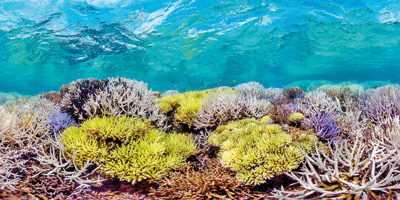News
Coral dance of death: Glowing, glowing, gone
Sri Lanka’s foremost coral expert, Arjan Rajasuriya, recently received a call from an excited diver friend. “I’ve just gone diving and found varieties of corals that I had never seen, glowing with fluorescent colours. They looked really beautiful,” the friend said.

Dying corals performing the dance of death
But the news held no excitement for Mr. Rajasuriya, only sadness. “Look, those are not a new variety of coral: they are just dying corals performing the dance of death,” he explained to his friend.
Coral is created by tiny creatures called coral polyphs, whose hard exoskeletons become part of the coral. To obtain food, these polyps often build a harmonious symbiotic partnership with the zooxanthellae algae, which produce food through photosynthesis and become the corals’ food supplier and also their source of colour.
Increasing temperatures cause the algae to leave the polyps, leaving the latter without food and vulnerable to disease. The coral gradually goes white without the algae and dies – a process called coral bleaching.
“During this process of coral bleaching some of the corals can appear much more colourful and brightly fluorescent. This is a spectacular sight – but it is only the dance of death of the corals,” Mr. Rajasuriya said.
As the sea surface temperature rises as a result of global warming, corals are at risk of dying everywhere and are the most threatened organisms on the planet, he added.
Coral bleaching is a serious problem in Sri Lanka with the live coral coverage of number of reefs having fallen to just 10-20 per cent of what they used to be. This is a worrying fact globally, with Australia’s famous Great Barrier Reef, for example, losing more than half of its live coral coverage mainly due to bleaching.
In order to highlight the impact of global warming on fragile coral ecosystems, a global campaign was launched last week on World Wildlife Day, March 3, called “Glowing, glowing, gone”, displaying three new colours symbolising the hues that dying corals take on prior to bleaching.
The campaign was initiated by the United Nations Environment Programme and The Ocean Agency, an international NGO dedicated to marine conservation, partnered by graphic design giant Adobe and the colour design company, Pantone Colour Institute.
In a press release, Adobe described how corals produce brightly-coloured chemicals as a kind of sunscreen against fatally high water temperatures and sun exposure. “This glowing phenomenon, called coral fluorescence, is a final line of defence before the coral dies and bleaches to white. It’s been described as ‘a most beautiful death’,” Adobe said.
“Only a handful of people have ever witnessed the highly visual spectacle of corals ‘glowing’ in vibrant colours in a desperate bid to survive underwater heatwaves,” The Ocean Agency founder, Richard Vevers, said in a statement. “Yet this phenomenon is arguably the ultimate indicator of one of our greatest environmental challenges — ocean warming and the loss of coral reefs.
“Glowing corals are a highly visual sign of climate change — an attention-grabbing indicator that we’ve reached a tipping point for the planet. We’ve turned these warning colours into colours to inspire action that everyone can use.”

Pantone, Adobe and The Oceans Agency together captured the exact colours of coral fluorescence and named them Glowing Yellow, Glowing Blue and Glowing Purple
Pantone, Adobe and The Oceans Agency together captured the exact colours of coral fluorescence and named them Glowing Yellow, Glowing Blue and Glowing Purple. They say this is the palette of colours of climate change that call “citizens of the world to recognise Earth’s major ecosystems in peril”.
Why worry so much about coral reefs, Arjan Rajasuriya was asked. “Corals are like the canary in the coal mine, acting as an indicator of upcoming disasters,” he replied. “The ocean surface absorbs large amounts of climate change heat, and corals are the first sign of increasing temperatures.
“There will be more catastrophes – the excessive carbon dioxide in the atmosphere will make oceans more acidic, and that will also have an impact on fishing,” Mr. Rajasuriya said.

